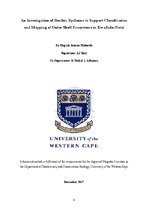| dc.contributor.advisor | Smit, AJ | |
| dc.contributor.author | Makwela, Mapula Salome | |
| dc.date.accessioned | 2018-04-18T09:36:10Z | |
| dc.date.available | 2018-04-30T22:10:07Z | |
| dc.date.issued | 2017 | |
| dc.identifier.uri | http://hdl.handle.net/11394/5971 | |
| dc.description | Magister Scientiae (Biodiversity and Conservation Biology) - MSc (Biodiv & Cons Biol) | |
| dc.description.abstract | Ecosystem classification and mapping are foundational steps for effective ecosystem-based
marine spatial planning, marine ecosystem assessment and integrated ocean management.
The aims of this study were to interrogate and refine existing ecosystem classification and
maps using quantitative data for epifaunal communities and to investigate the potential
physical drivers which may contribute most to the distribution patterns of these ecosystem
types. A total of 27 sites between Pennington and Ballito on the east coast of South Africa,
including unconsolidated sediment, mixed and reefs habitat types, in the 48 to 85m depth
range, was examined. Epifauna data were quantified from seabed imagery collected by
remotely-operated vehicle covering more than 13 130 epifaunal individuals counted
representing over 170 morphospecies from five taxa. Multivariate analyses of data from 17
sites surveyed in southern KwaZulu-Natal (KZN) revealed that epifauna at unconsolidated
sediment sites were significantly different to that occurring on either mixed or reef substrates
and epifauna occurring on mixed substrates were also significantly different to those
occurring on reefs. Epifauna at mixed sites were more similar to epifaunal assemblages at
reef sites than epifauna at unconsolidated sediment sites. | |
| dc.language.iso | en | |
| dc.publisher | University of the Western Cape | |
| dc.title | An Investigation of Benthic Epifauna to Support Classification
and Mapping of Outer Shelf Ecosystems in KwaZulu-Natal | |
| dc.rights.holder | University of the Western Cape | |

